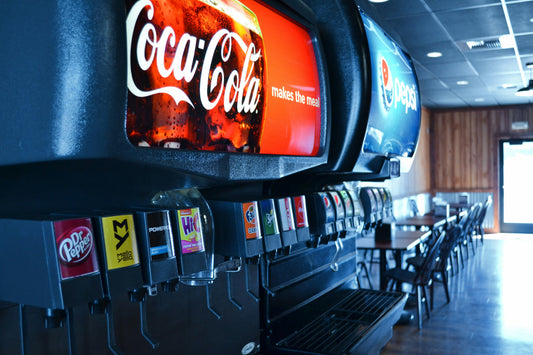The perfect storm
There are many products that have been promoted as safe consumption, which have been later found to be really damaging. And given we’ve seen this cycle repeat many times, I’m 100% sure it’ll happen again in the future. The level of knowledge of the negative impacts of such products, from corporations and individuals who promote them, is up for some debate. But if there’s an opportunity to make money, an industry regulator that approves a product for human consumption, and an insurer that is comfortable about the odds of problems coming back on their client’s business, or themselves being low, then you can bet a product will be sold. It’s truly the perfect storm for longer term health issues.
Are the studies done to inform the regulators unbiased, fair, or even accurate? Are the regulators totally impartial? Is lobbying influencing these major decisions? Do insurance companies care about consumers? Or are they simply focussed on whether the actions of their clients could be attributed to the negative health outcomes of customers, resulting in them having to pay out on policies?
I’m not here to answer these questions but simply to pose them. What I will say is, regardless of what big food and beverage companies tell you, it pays to do your own research, and to become yourself informed to be able to make smarter daily decisions.
Should cigarettes ever have been mass marketed?
In the past we’ve had cigarettes. At one point the symbol of a generation. Leather jacket-clad James Dean was rarely seen without one. John Travolta lighting up in pulp fiction. Cool right? Until you realise the horrible things that smoking does to your body.
We’ve had many responses in the UK, some of the most hard-hitting - putting graphic images of cancers on cigarette packets and limiting the age of consumption. Now there’s discussion about going even further and banning smoking in outdoor venues. There’s clearly a debate about the impact on venues, and an individual's right to choose to smoke. But going back to first principles, should we ever have mass marketed smoking? This little thing that may have looked cool to some, but seriously increases your odds of getting cancer, and dying prematurely.
Enter the vape
And now vaping. Marketed as a way to stop smoking, we’ve now realised it’s just as addictive. Not only that, practically and socially it’s possible to vape a lot more regularly. Then they created bubblegum, mixed berry, mango, and a plethora of other flavours. Say whatever you want but anyone with their head screwed on knows who that’s targeting… children.
And surprise surprise, we’re now finding out about the huge problems associated with it. Not the same as smoking, but seemingly bad in different ways - popcorn lung to name one of many. But yet vapes are still widely available in pretty colours being marketed even more aggressively at kids.
In 2022 the percentage of UK teens between the ages of 11-17 who had been promoted vapes from any source was at 56%. In 2023 it’s 69%. Not only are we not learning the lessons from the failures of cigarette marketing, we’re now targeting some of the most vulnerable people. And why would companies want to focus on teens? You’re old enough to make your own decisions and rebel against your parents, and young enough to feel invincible. Not old enough to think about the long term consequences of what you’re doing, and at the perfect point to develop a lifelong habit.
For all the negatives about vaping or smoking - there’s a lot of movement in those areas in terms of government policy. Yes we’ve got a long way to go, but in the UK at least we’re going in the right direction.
An ongoing overlooked disaster
But there’s a far more concerning problem right under your nose. One that is even less visible, targeting that same vulnerable audience. And one for which very little meaningful regulation is being put in place to protect consumers - the food and beverage industry. We have been in a major escalating health crisis for years. Since the advent of fast food in the 60s-70s, obesity has seen a steep incline. In the UK now we have one of the worst country rates of obesity and it’s still getting worse. In 1993, the number of UK adults (over 18) overweight or obese was 52.9% with (14.9% obese). In January 2023, the number rose to 64.3% (28.0% obese). What will it take for this trend to change? What will it take for us to not need to learn the same lessons again and again.
There are a myriad of problems here including lack of exercise, sedentary lifestyle, alcohol consumption, diet, and other lifestyle factors. Alcohol and diet rank at the top for me personally and here’s why. Alcohol is typically the gateway to lots of other bad behaviours. As Ed Sheeran said “if I have one beer, then I’m going to want another beer, and then I’m going to want a shot, and then I might want a cigarette and then I might want a big mac…”. On top of that, it’s addictive, and we get into it at 15-19 when we’re at our most impressionable, similar years might I add, to when vape companies are targeting you.
But even worse than that is diet. Many sources have quoted an 80:20 rule in terms of the impact of diet:exercise on weight loss. The accuracy of that is up to some debate but it’s a useful starting point. I’m not here to wax lyrical about vegan diets, keto, paleo, or anything else. I’m no expert on which of those would be best for your particular body type. However what I am absolutely sure of is that eating foods, and drinking liquids which are as close to how nature intended them is a healthier way to live your life. Mother nature did not design your body to consume vast quantities of sugar. And she certainly did not design it to consume artificial chemicals. Yet the vast majority of household name brands in the drinks space and the fast food space will include both in lashings in your food and drink.
Ok, but how bad is it really? What have we got to substantiate these claims. Well let's start with some context around this. Basic questions: How much sugar should I have in a day? What are the risks of the additives in some of these household name brands?
Sugar for adults
So starting with the sugar. The simple answer is, there is no dietary requirement for any sugar in your diet. The body breaks down carbohydrates into glucose, required for bodily function, but your body would be absolutely fine without any added sugar. Ok, that’s all well and good, but I do have a bit of a sweet tooth. Ok well there are various schools of thought on how much sugar you can consume, and admittedly I see why this is a source of some confusion.
Giving you a few key ones:
- The National Health Service (NHS) stipulates that adults should have no more than 30g of sugar a day. It states that anything more would have negative impacts on the body.
- The World Health Organisation (WHO) states that anything more than 25g of sugar per day causes health problems.
- Then you’ve got various others - doctors like Robert Lustig who state that men should limit sugar consumption to 38g or less, and women 25g a day.
So a bit of a variation. What do I do with these different numbers?
Firstly it’s important to remember there are lots of reasons for the different suggestions. There will be various circumstances which affect you as an individual such as sex, metabolism, height, weight, exercise amongst others. Secondly if you’re getting multiple recommendations for how much of something that’s deemed not necessary for your body, what would you think would be the right approach to choosing one. Personally I’d go for the lowest, but that’s just me. So if we assume 25g of sugar is ok for an adult. Thirdly it's vital to remember here, that you could get sugar from all sorts of sources within your day. It could be natural sugars from fruit or refined sugar from sweets or drinks. And finally I’d say that just because you’ve got a number to go off it’s best to reduce your intake below this as much as possible whilst still enjoying life. Going back to the point above, there is no dietary requirement for sugar. These are the levels at which your body can metabolise sugars, leading to minimal adverse health effects.
Sugar for kids
What’s scary about this is that many household name brands are giving you more than 35g or 140%+ of your adult daily sugar allowance in one 330ml can alone. And when you look at what kids should consume the numbers are even more stark. 12g-25g is the recommended daily limit depending on their age. Meaning some of those drinks are almost 3 times what they should consume every day… Is there any wonder kids get hyper after fizzy drinks?
Is diet better then?
Ok but what about diet drinks? Surely there are safe alternatives. Well this depends on what’s in them, and how much risk you want to take. Looking again at some household names you may find the following additives or sugar replacements commonly available: aspartame and acesulfame k. The science isn’t always conclusive on all of this, so we must avoid talking in absolute terms, but there is some ongoing debate about the potential link of aspartame with cancer and mood disorders. Research is still in the early stages, but Acesulfame K has also been linked with cancer risk, hormone interruption and pregnancy disruption.
These additives only really emerged in the 1970s, during the fast food revolution. They’ve come into being owing to the negativity surrounding sugar, but make no mistake they are not the golden bullet. We know sugar is bad, yes, but we’ve got clear advice on the dangerous level, whereas these artificial alternatives are billed as having no downside in small amounts. How common is such a thing in life - all good with no bad? And what is the likelihood that evidence may emerge at some point to the contrary? Given that, is it really worth taking the risks?
Nutrition labels can also be misleading
Unfortunately to make matters worse for you, there’s a few other things that you need to look out for. It’s industry standard to talk about nutritional info per serving which in drink terms is commonly, per 100ml. So whatever you see on the back of the can, you need to times it by the overall size of the can.
For example - If a 330ml canned drink has 10.6g per 100g. The actual sugar content per can is 35g (10.6*3.3).
And there’s no standard that states you have to show the sugar based on the whole product. They also may show the % of your recommended daily allowance of sugar that 100ml of the drink is contributing towards.
- For example you might be told that 10.6g per 100ml is 35% of your daily sugar allowance (using NHS recommended 30g per day for adults).
- So 330ml contains 35g of sugar or 117% of your daily recommended allowance.
- Using our 25g limit it would be 140% of your daily allowance.
- And if you used the lowest children's allowance of 12g, this would be 292%. Is there any wonder kids get so hyper after a coke?
I appreciate this is a lot of information to take in. Hopefully that’s given you some ideas about how to be informed about what you’re reading on the back of food and drinks packaging. If I could leave you with a few takeaways they would be these.
In summary:
- Sources vary, but a max daily sugar intake of 25g for adults is reasonable.
- This decreases the younger you are.
- For children between 4-6 it should be no more than 12g per day.
- Below this age no added sugar should be consumed.
- The amounts provided are an estimate of what your body can safely metabolise every day.
- Anything more will have adverse health effects.
- This will however vary depending on personal circumstances, and conditions such as diabetes.
- Whilst it’s important to enjoy food and drink you should aim to stay well below this allowance on a daily basis.
- Be aware how much sugar is in the full drink you’re consuming, not just the suggested serving size (e.g. 100ml).
- Remember that sugar will feature in many different foods and drinks, not just ones with nutritional labels.
- Read up on the different additives that drinks companies include in their drinks, and the related risks.
- Be mindful that some nutritional labels are misleading. There’s a reason why they’re trying to avoid telling you the truth.
- Try to make sensible decisions that are suitable for you, and base them on your own research.
There are lots of brands which are out there trying to make healthy products across the food and beverage industry. We appreciate that people always want treats, but my preference is having sensible treats that are minimising long term damage to your body. Good luck!










